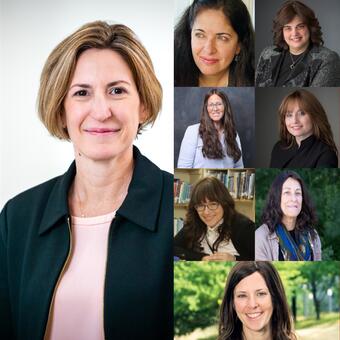By Dave DeFusco
In the aftermath of the October 2023 attack on Israelis, Jewish occupational therapists from the Katz School and other universities gathered at the American Occupational Therapy Association (AOTA) Inspire 2024 Annual Conference & Expo to reflect on how occupational therapy can address intergenerational trauma and promote diversity.
“We had a spirited discussion on how to support Jewish occupational therapy practitioners and students with members of the Multicultural Diversity and Inclusion Network,” said Dr. Robin Akselrud of Touro University, “while also delving into the complexities of how trauma—both Jewish and non-Jewish—is transmitted across generations, often without conscious awareness.”
Dr. Akselrud was joined in the conversations by her colleagues, Dr. Rivka Molinsky and Shifra Leiser, of Touro University; Dr. Amiya Waldman-Levi of the Katz School’s Occupational Therapy Doctorate; Dr. Lola Halperin of Sacred Heart University; Dr. Zahava Friedman of Kean University; Dr. Lisa Gordon-Handler of Hofstra University; and Dr. Avital Isenberg of the University of Pittsburgh.
The sessions, held at the Orange County Convention Center in Orlando, explored how to incorporate cultural humility and trauma-informed care into occupational therapy interventions for Jewish and non-Jewish clients. During the conversation, they explored how recent trauma echoed past experiences. They reexamined intergenerational trauma, relating the current events back to historical and familial wounds, many of which had long been buried but were suddenly and powerfully resurfaced.
“Trauma isn’t always an explicit memory,” said Dr. Halperin. “It’s woven into the fabric of family stories, community experiences and cultural norms.”
This was especially clear in their conversations with colleagues and clients. The October 7 events triggered memories and anxieties that connected back to historical traumas, particularly among Jewish people, although it wasn’t always immediately recognized. In some cases, third-generation students—grandchildren of Holocaust survivors—spoke about fears and anxieties that they realized were part of this legacy, passed down through stories, unspoken narratives and even cultural patterns.
But the conversation went beyond the personal. The researchers began to explore the epigenetic aspect of trauma, a field that has gained significant traction in recent years. Studies suggest that trauma can leave a chemical mark on a person’s genes, which can then be passed down to future generations. These marks don’t alter the genetic code itself but change the way genes are expressed. For many descendants of Holocaust survivors and others who have experienced large-scale atrocities or extreme hardship, this concept validates the notion that suffering is inherited, not just emotionally or behaviorally but biologically. This contributes to a collective understanding of how trauma can influence health, behavior and resilience across generations.
“Trauma-informed care in occupational therapy is an essential approach when working with individuals affected by trauma, including intergenerational trauma,” said Dr. Friedman. “This approach focuses on creating a therapeutic environment that acknowledges the deep impact trauma has on a person’s life.”
Safety, trust, empowerment, peer support, collaboration and cultural humility are critical in ensuring that therapy is not just about treating symptoms but about understanding and validating the client’s entire life experience.
“In the aftermath of October 7, clients talked about current events but, in doing so, connected them to stories they had heard from their parents or grandparents—stories of persecution, displacement, and survival,” said Dr. Isenberg. “This showed that trauma wasn’t just about the present. It was about the past and the layers of experience that individuals carried, often unknowingly.”
A former student of Dr. Waldman-Levi, Dr. Amanda Hoberman, who graduated this year from the Katz School, developed educational modules for OTs to address trauma-informed care, underscoring the necessity of proper training. Many healthcare providers, OTs included, feel ill-prepared to assess and treat victims of trauma, particularly when it comes to understanding the complexities of trauma's impact on occupational performance.
“Amanda’s work highlighted the need for trauma-informed care to be a core part of healthcare education,” said Dr. Waldman-Levi, “as trauma affects not just mental health but daily functioning and engagement in life’s meaningful activities.”
As the conference unfolded, they realized that addressing intergenerational trauma isn’t just about healing individual wounds; it’s about recognizing the cultural, communal and familial legacies that shape how people live, work and interact today. This was especially evident in the Jewish experience, but it also applied to other communities—African Americans, indigenous peoples, refugees and more—all of whom carry the scars of historical and generational trauma.
“The continuum of trauma impacts those who experience it firsthand, and then their children and grandchildren as well,” said Dr. Molinsky. “Understanding this in the context of occupational therapy allows therapists to approach care with more empathy and sensitivity, and an awareness of the complex forces that shape a person’s life.

